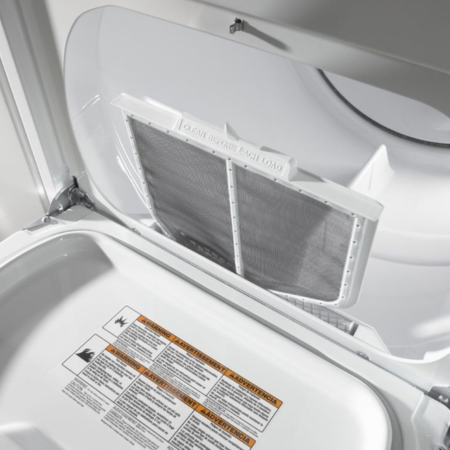Understanding why is your Whirlpool dryer not heating is essential for keeping your laundry routine efficient and for safety reasons.
Failure to heat can be due to various reasons – from minor issues such as incorrect settings to more complex ones like a malfunctioning heating element or blown thermal fuse.
This article will guide you through a step-by-step process of diagnosing and addressing the issue of a Whirlpool dryer not heating.
Our goal is to equip you with essential information to ensure your dryer is functioning at its best and save you from costly professional repairs.
Key Points
- Check The Settings: Incorrect settings can cause the dryer not to heat. Ensure you have not accidentally set it to ‘Air Dry’ or ‘Fluff Air,’ which doesn’t use heat.
- Inspect The Heating Element: The heating element generates the heat for drying clothes. If it’s broken or burnt out, it needs to be replaced.
- Examine The Thermal Fuse: A blown thermal fuse can prevent the dryer from heating. Test it for continuity and replace it if necessary.
- Look At The Cycling Thermostat: This device controls the temperature of the dryer drum by switching the heat source on and off. A malfunctioning cycling thermostat may cause the dryer not to heat up.
5 Reasons Why Whirlpool Dryer Not Heating
Let’s delve into the primary causes behind the Whirlpool dryer’s inability to heat.
We’ll discuss five common reasons, giving you a fundamental understanding of each issue.
This knowledge will empower you to effectively troubleshoot the problems, saving you time, effort, and possibly some money too.
1. Incorrect or Inappropriate Dryer Setting
Incorrect or inappropriate dryer setting is a common problem. Check your dryer setting first.
Sometimes, it’s not a technical issue.
You might have selected a setting without heat.
For example, ‘Air Fluff‘ or ‘No Heat’. These settings are designed not to use heat.
They are there to help freshen up fabrics. So, if you choose them, your clothes will tumble but not get dry.
Another case could be setting the dryer on ‘Auto Dry’.
This setting senses moisture levels.
Once it senses the clothes are dry, it stops heating.
If your clothes are still damp, the sensors might be dirty. Clean the sensors and try again.
Make sure you select the right settings. If you are unsure, consult your dryer’s user manual.
The solution could be as simple as hitting the right buttons.
Solution
Check your dryer’s settings. Ensure it’s not on ‘Air Fluff’ or ‘No Heat’. These modes don’t use heat. Your clothes will tumble, but they won’t dry. Also, avoid ‘Auto Dry’ if clothes are damp.
This setting stops heating when it senses dryness. Clean the sensors if this occurs. Always refer to your user manual when in doubt. Correct settings are often the easiest solution.
2. Faulty Heating Element
A faulty heating element could be your problem. This is a common issue. Your dryer’s heating element may burn out. This would cause no heat.
You’ll have to check this. First, unplug your dryer. Always prioritize safety.

Next, locate the heating element. It’s usually at the back. You’ll need to remove the back panel.
Inspect the heating element. Look for any break or burn marks. If you see any, it’s damaged. You’ll need to replace it.
Remember, this task requires some technical skills. If you’re not comfortable, call a professional. They can diagnose and replace the element.
Also, be aware that other issues might mimic a faulty element. These include a blown thermal fuse or a defective thermostat. So, be sure to check these as well to avoid unnecessary replacements.
Solution
First, ensure the dryer is unplugged. Find the heating element at the dryer’s back. Remove the back panel. Look at the heating element. Check for any breaks or burns. If damaged, replace it. If unsure, call an expert. They’ll handle the task. Also, a blown thermal fuse or a bad thermostat could mimic a fault. Always check all possible issues before replacement.
3. Malfunctioning Thermostat
A malfunctioning thermostat is another potential issue.
It’s a crucial part of your dryer. It measures and regulates heat.
If it’s defective, it could lead to no heat. There could be several reasons. Maybe the thermostat is stuck open.
Or it’s not reading temperatures correctly. Either way, it won’t heat up.
First, ensure your dryer is unplugged.
Then, locate the thermostat. It’s usually near the blower housing.
Look for signs of damage.
You might see blackened areas or melting. If it looks damaged, you’ll need a replacement.
Remember, handling the thermostat requires caution. If you’re uncertain, consult an expert.
They can perform the replacement safely.
Finally, keep in mind that a bad thermostat resembles other issues. Always check all possibilities before replacing parts.
This will save you unnecessary costs and effort.
Solution
First, unplug the dryer. Locate the thermostat near the blower housing. Check for damage. Blackened or melted areas indicate damage. If damaged, replace it. Be careful when handling the thermostat. If unsure, ask an expert. They can safely perform the replacement. Remember, other issues can mimic a bad thermostat. Always examine all possibilities before replacing parts. This can save unnecessary expenses and effort.
4. Blown Thermal Fuse
A blown thermal fuse is a common dryer issue. This fuse is a safety feature. It prevents overheating. When it blows, your dryer won’t heat up.
First, unplug your dryer. Safety first. Now, locate the fuse. It’s generally near the exhaust duct. Next, inspect for damage. A blown fuse looks discolored. It might also display physical damage.
If it’s blown, replace it. Be careful. If you’re unsure, call a professional. They will handle the task.
But, this isn’t the only problem that mimics a blown fuse. Other issues can also lead to no heat. So, always check everything. This avoids unnecessary replacements. It saves you both time and money.
5. Blocked Ventilation System
Blockage in the ventilation system is another cause of your dryer’s heating troubles. It’s a vital component. The system expels hot air from the dryer. A blockage stops it from doing this effectively.
First, you must disconnect the dryer. Safety is always the top priority. Then, locate the ventilation system. It’s typically at the back of the dryer. Check it for any signs of blockage.

Common culprits are lint or small clothing items. If you find such blockage, clear it out. Note that this process can be messy. So, prepare accordingly.
Remember, consult a professional if you’re not confident in doing this. They have the right tools and knowledge for the task.
A blocked ventilation system can look like other problems. Therefore, always cross-check all possibilities. This can save you unnecessary effort and replacement costs.
Solution
The solution is simple. Regular cleaning is vital. Clean the lint filter after each use. Don’t neglect the exhaust duct. Clean it every six months. This prevents blockages. It also ensures optimal dryer function. Remember, safety comes first. Always unplug your dryer before any cleaning. If unsure, get professional help. This keeps your dryer safe. It also extends its lifespan.
When To Call A Professional?
There are signs when professional help is needed. Major issues are one. Call a pro if your dryer won’t start or keeps switching off.
Also, if you spot sparks or smoke, it’s time to ring an expert. Another sign is when you’ve tried all troubleshooting steps but no luck. Don’t experiment further. Avoid causing more damage. A professional has the right skills and tools.
They can correctly diagnose and fix the problem. It might cost more initially. But it’s worth it. You’ll save time. Also, you’ll prevent more expensive repairs in the future.
Frequently Asked Questions
1. What could be the causes of my Whirlpool dryer not heating?
Several factors could cause your Whirlpool dryer not to heat. These include a blown thermal fuse, a defective heating element, a malfunctioning thermostat, a faulty timer, or even a tripped circuit breaker. Each of these problems interrupts the heating process of the dryer in different ways, making it unable to produce heat.
2. How do I check if the thermal fuse is blown?
The thermal fuse is a safety device that protects the dryer from overheating. If your dryer is not heating, it could be due to a blown thermal fuse. To check, you need a multimeter to test it for continuity. A fuse without continuity needs to be replaced.
3. How can I fix a malfunctioning thermostat?
If your dryer’s thermostat is malfunctioning, it might not accurately regulate the dryer’s temperature, resulting in no heat. You can replace a faulty thermostat yourself, or hire a professional to do it. Ensure you purchase the correct replacement part and follow the manufacturer’s instructions carefully.
4. What if the problem is a tripped circuit breaker?
A tripped circuit breaker can stop your dryer from heating even though it still runs. To fix this, locate your home’s electrical panel, find the breaker that controls your dryer, and see if it’s in the “Off” or “Tripped” position. If it is, flip it back to the “On” position. But remember, frequent tripping might indicate a more serious electrical problem, and you should consult a professional.
Conclusion
Regular maintenance is key to a properly functioning dryer. Clean the lint filter after each use. This avoids blockage.
Also, clean the exhaust duct every six months.
Doing so ensures the dryer’s optimal function. Before cleaning, always unplug the dryer. Safety should be your primary concern.
If you’re unsure, hire a professional. This can prolong your dryer’s life.
- Can You Put Metal In A Convection Microwave: 10 Major Risks - May 12, 2024
- Can You Use A Microwave Without The Glass: 10 Benefits - May 11, 2024
- Can You Put Wood In A Microwave: 10 Major Tips For Safety - May 10, 2024

